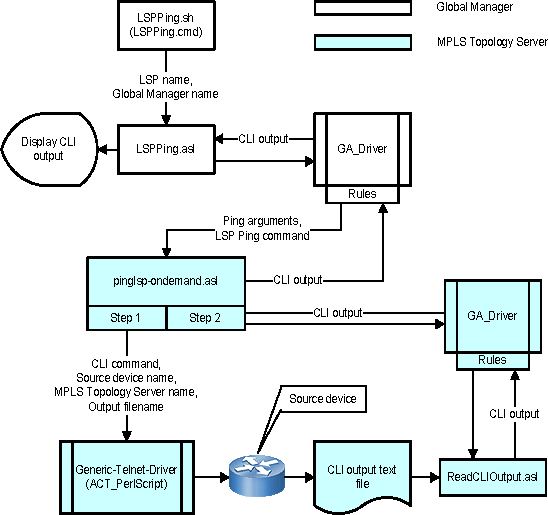Once you have determined the action to be performed by the CLI-based server tool, perform the following tasks to create the tool scripts and auxiliary files for the tool:
-
Create the system-specific tool execution files for the tool.
-
Write the local and remote tool scripts to accomplish the determined action for the tool.
-
Assign the proper read/execute permissions to the tool scripts.
-
Save the tool execution files to the BASEDIR/smarts/actions/server directory and the tool scripts to the BASEDIR/smarts/rules/ics directory.
-
Test the tool to ensure that it executes properly.
The LSP ping flow shown in LSP ping flowchart helps clarify the following sequence of events executed by a CLI-based server tool when the tool is invoked:
-
Start the local and remote tool scripts.
-
Acquire the appropriate login credentials to access the source (originating) network device, invoke the desired CLI command or commands, and save the results to a data file.
-
Read the results in the data file, parse and analyze the results, and report the results to the initiator of the tool.
Figure 1. LSP ping flowchart 
ReadCLIOutput.asl, an ASL script in the BASEDIR/smarts/rules/mpls-t directory in the MPLS Management Suite installation area, is used for reading the CLI output data.
LSPPing.sh (LSPPing.cmd) and LSPPing.asl are run by the Global Manager, and pinglsp-ondemand.asl and ReadCLIOutput.asl are run by the MPLS Topology Server. Note that pinglsp-ondemand.asl is located in the Global Manager installation area but is executed by the MPLS Topology Server.
Also, note that LSPPing.asl creates an instance of the Generic Adapter Driver (GA_Driver) to run pinglsp-ondemand.asl and to return the ping test results, and that pinglsp-ondemand.asl creates an instance of the GA_Driver to collect and return the ping test results.
As explained in Chapter 7, “Configuring SSH or Telnet Remote Access,” the MPLS Topology Server uses the Telnet CLI package by default, but can be configured to use the SSH-Telnet CLI package. The Telnet CLI package is assumed in this discussion.
-